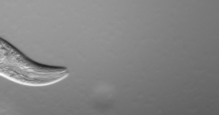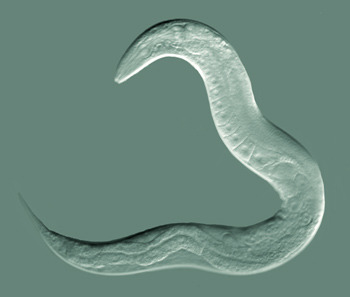#nematodes
Explore tagged Tumblr posts
Photo

Where nematodes are found most inside the soil
487 notes
·
View notes
Note
I too wanna gacha for the Critter Cards. Maybe I'll pull an extra rare critter. Assign me a critter. I hope it's a cool one. Like the bacteriophages we all know and love.
String identified: t aa gaca t Ctt Ca. a ' a ta a ctt. Ag a ctt. t' a c . t actag a a .
Closest match: Caenorhabditis wallacei genome assembly, chromosome: II

(image source)
#tumblr genetics#genetics#science#biology#asks#requests#sent to me#anon#nematodes#caenorhabditis wallacei#YEAHHHH NEMATODES
383 notes
·
View notes
Text
@i-give-you-a-fish
I'll trade you a pathogen for a fish :D
Pathogen assigned: Anisakis simplex
Cause of anisakiasis, type of nematode

(Image from Wikipedia article)
Spread via: Consumption of undercooked salmon, mackerel, squid etc.
145 notes
·
View notes
Text
The soil fungus Mortierella alpina has the potential to make agriculture greener and more sustainable: The fungus produces bioactive molecules called malpinins, which could protect plants from destructive worms. A research team from Jena has now been able to understand and describe their mode of action for the first time. The study was published in the Journal of the American Chemical Society. The story begins under our feet: Soils are not only a complex habitat, but also a battlefield where tiny nematodes fight against fungi and plant roots. Agriculture in particular suffers as a result. Out of concern about crop losses, the worms are conventionally controlled with chemical pesticides. However, these are increasingly being criticized for potentially damaging the soil and water. With a view to the future, alternatives must be found for sustainable agriculture.
Continue Reading.
97 notes
·
View notes
Text
Taxonomy Tournament: Invertibrates


Articulata. This class is made up of sea lilies, which have a stalk an attach themselves to substrate in their adult forms, and feather stars, which are free-moving. They feed using arms with feathery pinnules.
C. elegans. This nematode species is commonly used as a model organism, being the first multi-cellular organism to have its genome sequenced and neural connections mapped
#animals#biology#polls#poll tournament#zoology#Animal Tournament Round 4#sea lilies#echinoderms#nematodes#worms#ecdytes#Articulata#C. elegans#0x14v0x15
41 notes
·
View notes
Text
Elemental Planes of Water, Fire, Light, and so on are neat and all, but what about the Elemental Plane of Nematodes
If all the matter in the universe except the nematodes were swept away, our world would still be dimly recognizable, and if, as disembodied spirits, we could then investigate it, we should find its mountains, hills, valleys, rivers, lakes, and oceans represented by a film of nematodes. The location of towns would be decipherable since for every massing of human beings there would be a corresponding massing of certain nematodes. Trees would still stand in ghostly rows representing our streets and highways. The location of the various plants and animals would still be decipherable, and, had we sufficient knowledge, in many cases, even their species could be determined by an examination of their erstwhile nematode parasites.
-- Nathan Cobb, "the father of nematology", ca. 1915
7 notes
·
View notes
Text

🌈INSIDE FRIENDS🌈
#procreate#procreate art#digital art#digital painting#procreate painting#horror#horror art#body horror#body horror art#worm#worms#parasite#parasites#nematodes#tapeworms#gore#blood#portrait#inside friends
7 notes
·
View notes
Text

Haven’t posted much since it’s been dead week and finals, but this was one of my final projects; teaching the general public about my lab! I really am proud of it (aside from the occasional error when typing the transcript, i was tired tho) and wanted to share it with you all. :)
#art#drawing#doodle#oc#my oc art#original character#omega’s art#Jack Somnus#Jack Oogie Somnus#Doctor Jack Somnus#ocs#science#science comic#nematodes#slugs
8 notes
·
View notes
Text
February 11th, 2024


The Worm (Caenorhabiditis elegans)
Distribution: Found in temperate regions worldwide.
Habitat: Terrestrial; lives in humid soils with moderate oxygen contents and low-to-medium clay contents.
Diet: Microbivorous; feed on bacteria that lives in soil and on rotting vegetation, but can also feed on various species of yeast.
Description: C. elegans is aptly nicknamed "the worm" because it is a very common laboratory model; in fact, it's used as the model organism for all eukaryotic organisms! These worms are very easy to study due to the transparency of their body, as well as their limited number of cells, having only 131 cells in their entire bodies. They were the first multicellular organisms to have their entire genome sequenced (as they only have 6 chromosomes and approximately 20,000 genes). Common research on these worms include the processes of embryogenesis, development, disease and aging (especially in the form of programmed cell death). By understanding how their genes are involved in the aging process, we can hopefully have a better idea of the processes involved in human aging, too!
Most of these worms are self-fertilizing hermaphrodites, though males are also present (composing only about 1/1000 worms). Though their anatomy is quite simple, they do possess a simple brain and nervous system (one third of their cells are neurons). They're also capable of rudimentary learning, as well as using chemoreceptors to orient themselves, and respond minimally to light (living in dark environments, they don't have much need for good eyesight).
Image by K. Bradnam and gif by Bob Goldstein.
39 notes
·
View notes
Text


Coprinus comatus, The shaggy inkcap is a super intersting mushroom and metal as fuck.
First of all, the young mushrooms are edible and very tasty, but as soon as they get bigger, the hat starts dissolving into a black goo that drips down and makes it look like a fantasy trope type of corruption is spreading through the lands.
Actually tho it's because the gills of the mushroom digest themselves to produce that goo which contains all the spores for dispersal.
But that's not the most metal thing about it.
No, the shaggy inkcap is also a nematophagous fungus, i.e. it kills and eats tiny worms called nematodes to supply extra nitrogen.
There's a whole bunch of nematophagous fungi and they use different methods to kill the nematodes. There's five groups:
Nematode-Trapping most of these produce a type of glue that traps the nematodes, but some actually produce microscopic slings which contract and strangle a nematode if one happens to crawl through.
Ovicidal These fungi grow their mycelium into the eggs of nematodes and digest them
Endoparasitoid 'The nematodes ingest spores and the fungi will grow out of the nematode from the inside.
Toxin-Producing Oyster mushrooms belong to this group. They produce a toxin which immobilizes the nematodes and implodes their heads.
Special Attack Devices
Now these last two groups is where the shaggy inkcap comes in.
The hyphae (which are the stingy cells of the mycelium) grow absolutely microscopic structures which the scientific literature calls
"spiny balls"


They produce a toxin which immobilizes the nematode and then they veery slowly grow towards them and bonk them on the head with a morningstar ripping them apart. They then grow into the nematode with what scientific literature calls a "penetrating peg" and digest them from the inside. Metal as fuck
Sources: Luo et al. "Coprinus comatus: A Basidiomycete Fungus Forms Novel Spiny Structures and Infects Nematode", 2004 Soares et al. "Nematophagous fungi: Far beyond the endoparasite, predator and ovicidal groups", 2018
#mine#nature photography#original photography#mushrooms#fungi#nematodes#nature#coprinus comatus#shaggy inkcap#schopftintling#science#biology#mycology
17 notes
·
View notes
Text

In a Spindle
Live imaging and electron tomography in cells of the tiny worm Caenorhabditis elegans (C.elegans for short) reveal fine details of the changes in cell structure occurring during female meiosis – specialised cell division for sexual reproduction to produce egg cells with only one pair of chromosomes. The length of the meiotic spindle (a transient assembly of proteins that forms to segregate chromosomes) is correlated with the length of microtubules – tiny flexible pipes formed of a protein called tubulin – which comprise most of the spindle proteins.
Read the published article here
Image from work by Vitaly Zimyanin and Stefanie Redemann
Department of Molecular Physiology and Biological Physics, University of Virginia School of Medicine, Charlottesville, VA, USA
Image originally published with a Creative Commons Attribution – NonCommercial – NoDerivs (CC BY-NC-ND 4.0)
You can also follow BPoD on Instagram, Twitter and Facebook
#science#biomedicine#immunofluorescence#biology#cells#meiosis#cytoskeleton#microtubules#meiotic spindle#c.elegans#nematodes
12 notes
·
View notes
Text
Your Ants
There are 2.5 million ants per person. I like to think specific colonies are assigned to each of us. Your *particular* ants.
Perhaps you have been assigned just three massive colonies of leaf cutters. Perhaps you are assigned 10,000s of tiny colonies of many different species each with dozens to 100s of ants.
But, what is more remarkable is that *each* of your assigned ants has to her (or occasionally him) assigned about 22,800 nematodes.
How do the little girls keep track of them all?
#nematode#nematodes#ants#ants per person#ant facts#your ants#antblr#ant posting#worm posting#round worms#ants per worm#world of ants#planet of the ants
40 notes
·
View notes
Note
every time you post a cool looking bug I get obsessed w the little guys tbh. like I got a new favorite moth because of you. 10/10 best blog on the website
String identified: t t a c g g gt t tt g t. gt a at t ca . / t g t t
Closest match: Caenorhabditis sinica genome assembly, chromosome: IV

(image source)
363 notes
·
View notes
Text

I can’t believe I haven’t seen anything about this yet
Here’s a source
#science#animals#stem student#stemblr#studyblr#nematodes#wormblr#supernatural meme#news#scientist#what the fuuuuuuuuck#what the fuck#what the actual fuuuuuck#what the hell#that’s not gonna end well
55 notes
·
View notes
Text
Microscopic worms that live their lives in the highly radioactive environment of the Chernobyl Exclusion Zone (CEZ) appear to do so completely free of radiation damage. Nematodes collected from the area have shown no sign of damage to their genomes, contrary to what might be expected for organisms living in such a dangerous place. The finding, published earlier this year, doesn't suggest the CEZ is safe, the researchers say, but rather the worms are resilient and able to adroitly adapt to conditions that might be inhospitable to other species. This, says a team of biologists led by Sophia Tintori of New York University, could offer some insights into DNA repair mechanisms that could one day be adapted for use in human medicine.
Continue Reading.
116 notes
·
View notes
Text
Taxonomy Tournament: Nematode Finale!


C. elegans. This nematode species is commonly used as a model organism, being the first multi-cellular organism to have its genome sequenced and neural connections mapped
Dracunculus medinensis. This nematode is among the longest nematode parasites in humans, at up to 80 cm. They burst out of their host's foot, and are on target to be the second infectious disease to be eradicated, after smallpox. Possibly the ''snake'' depicted on the Rod of Asclepius (symbol of medicine)
#animals#biology#polls#poll tournament#zoology#nematodes#worms#ecdytes#Human parasite#C. elegans#Dracunculus medinensis#0x15v0x6a
35 notes
·
View notes